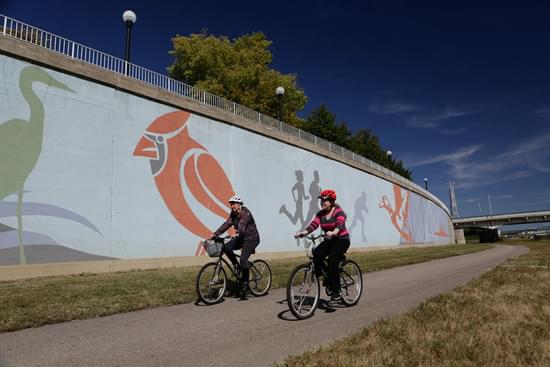




The Federal Highway Administration (FHWA), part of the US Department of Transportation, provides expertise, resources, and information to improve the nation's highway system and its intermodal connections. The Federal-Aid Highway Program provides financial assistance to the States to construct and improve the National Highway System, other roads, bridges, and trails.

The Federal Highway Administration (FHWA), part of the US Department of Transportation, provides expertise, resources, and information to improve the nation's highway system and its intermodal connections:
University Course on Bicycle and Pedestrian Transportation contains modular resource material that is intended for use in university courses on bicycle and pedestrian transportation. The Student Workbook (this document) contains 24 lessons that span a wide range of topics including an introduction to bicycling and walking issues, planning and designing for bicycle and pedestrian facilities, and supporting elements and programs. Scripted slideshows for all 24 lessons are available to facilitate course development and delivery. An overview lecture and scripted slideshow also is provided when a one- or two-lecture overview is needed for existing undergraduate or graduate courses
Pedestrian Facility Design: This course was developed to provide information and application opportunities for those involved in the design of pedestrian facilities. The Americans with Disabilities Act (ADA) requires newly constructed and altered sidewalks to be accessible and usable for people with disabilities, and accessibility improvements need to be implemented for existing facilities
Bicycle Facility Design: This course will assist planners and designers in learning how to apply existing bicycle facility standards and how to deal with other technical issues.
NEPA and Transportation Decision Making considers FHWA's policies and procedures for applying the National Environmental Policy Act (NEPA) to the project development and decisionmaking processes related to transportation facilities
Other FHWA Training Opportunities are available through the National Highway Institute.
State Trail Administrators Training
State Trail Administrators meet annually for training on Recreational Trails Program administration, trail development, accessibility, and other issues.
Recreational Trails Program
The Recreational Trails Program provides funds to the States to develop and maintain recreational trails and trail-related facilities for both nonmotorized and motorized recreational trail uses. Examples of trail uses include hiking, bicycling, in-line skating, equestrian use, cross-country skiing, snowmobiling, off-road motorcycling, all-terrain vehicle riding, four-wheel driving, or using other off-road motorized vehicles. The RTP funds come from the Federal Highway Trust Fund, and represent a portion of the motor fuel excise tax collected from nonhighway recreational fuel use: fuel used for off-highway recreation by snowmobiles, all-terrain vehicles, off-highway motorcycles, and off-highway light trucks. Each State has a designated agency to solicit and select projects for funding. Contact your State for specific eligibility requirements.
Projects include trail maintenance and construction, developing and rehabilitating trailside and trailhead facilities ranging from signs to restrooms, acquiring trail easements or property, and trail assessments for accessibility and maintenance. States may use up to 5 percent of their RTP funds for trail education related to safety and environmental protection and trail patrols. See more information on FHWA's RTP website. FHWA encourages the States to use qualified youth conservation or service corps for trail construction and maintenance projects. See www.corpsnetwork.org for more information about qualified youth corps.
Transportation Enhancement Activities improve the transportation experience in and through local communities through projects including pedestrian and bicycle facilities, scenic and historic highway programs, landscaping, historic preservation, and environmental mitigation. Each State administers its own program through its State Department of Transportation; see State contacts at www.enhancements.org/contacts.asp. FHWA encourages the States to use qualified youth conservation or service corps to perform appropriate TE activities. See www.corpsnetwork.org for more information about qualified youth corps.
Federal Lands Highway Program (FLHP) funds may be used to construct roads and trails within (or, in some cases, providing access to) Federal lands. There are four categories of FLHP funds: Indian Reservation Roads, Public Lands Highways, Park Roads and Parkways, and Refuge Roads. Funds available to the US Forest Service may be used for forest development roads and trails. To be eligible for funding, projects must be open to the public and part of an approved Federal land management agency general management plan.
FLHP funds appropriated to a Federal land management agency may be used to pay the non-Federal share of the cost of any Federal-aid highway project that provides access to or within Federal or Indian lands. This allows Federal agencies to use FLHP funds to match Transportation Enhancement, Recreational Trails, or Scenic Byways funds.
Best practices for sidewalks and trails
FHWA produced Designing Sidewalks and Trails for Access to identify best practices and provide guidelines for increasing the accessibility of sidewalk and trail designs. The project covered a wide range of outdoor paths of travel, but focused primarily on sidewalks and trails in more developed areas. See:
1) Designing Sidewalks and Trails for Access - Part I of II: Review of Existing Guidelines and Practices
2) Designing Sidewalks and Trails for Access - Part II of II: A Best Practices Design Guide
Trail Publications
FHWA partners with the US Forest Service to develop and produce many trail related publications. Additional FHWA publications cover pedestrian and bicycle design and safety, accessible transportation facilities, and planning issues. See https://www.fhwa.dot.gov/environment/recreational_trails/publications/index.cfm for more information.